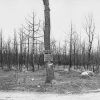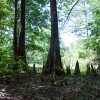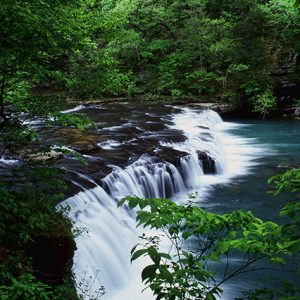calsfoundation@cals.org
Ozark-St. Francis National Forests
The Ozark-St. Francis National Forests are replete with distinct topographical, geological, and biological features. The forests are overseen by the U.S. Department of Agriculture (USDA) Forest Service, which employs a multiple-use management concept to serve the best interests of the landowners and visitors. The forests serve as a source of renewable hardwood for industry and as prime recreation areas in the state.
On December 18, 1907, President Theodore Roosevelt signed a proclamation creating the Arkansas National Forest (now the Ouachita National Forest) from the land south of the Arkansas River. On March 6, 1908, he signed the proclamation creating the Ozark National Forest from the land north of the river. The Ozark National Forest was the only major hardwood timberland under governmental protection at that time, and the forest would assist the furniture industry in northwest Arkansas as a renewable source of valuable hardwood.
The first forest headquarters was in Fort Smith (Sebastian County). Samuel J. Record was the first forest supervisor, administering both the Arkansas (Ouachita) and Ozark national forests. Late in 1908, the Ozark National Forest received its own supervisor, David Fitton, who moved the headquarters to Harrison (Boone County). In 1918, the headquarters were moved to Russellville (Pope County). The headquarters are located in the historic Koen Building downtown, as of 2009.
Presidential proclamations increasing and decreasing the area of the Ozark National Forest occurred frequently during the early years. Three of the more significant changes were the executive order of President Franklin Roosevelt transferring the Magazine Ranger District from the Ouachita National Forest to the Ozark; the addition of the Henry R. Koen Experimental Forest on June 14, 1950; and the proclamation of President Dwight D. Eisenhower on November 8, 1960, creating the St. Francis National Forest.
The 23,600-acre St. Francis National Forest is named for the St. Francis River, one of the rivers forming the eastern forest boundary. Most of the forest is situated in the hilly Crowley’s Ridge section, with some low and flat lands along the St. Francis and Mississippi rivers. The forest lies in Lee and Phillips counties. The St. Francis National Forest was originally the Mariana-Helena Project, which consisted of 22,000 acres located in the Crowley’s Ridge area of Arkansas and managed at the time by the U.S. Soil Conservation Service. In 1960, the majority of this land was designated as the St. Francis National Forest and, on January 15, 1961, was placed under the administration of the Ozark National Forest.
The Ozark-St. Francis National Forests are now jointly administered by the forest supervisor in Russellville. Some of the conservation activities overseen by the administrators of the Ozark-St. Francis National Forests include several designated wilderness and wildlife management areas, timber-harvesting activities, prescribed burning, and many other administrative tasks necessary to the operation of the forests. Combined, the forests account for more than 1.2 million acres of national forest land in the state.
From the low-lying Delta to the rugged, deep terrain of the Ozarks, the Ozark-St. Francis National Forests offer visitors many ways to enjoy Arkansas’s public lands, including camping, hiking, canoeing, and scenic driving. As of 2009, there are twenty-three campgrounds with 320 campsites, 360 miles of established multiple-use trail systems, and more than 230 miles of hiking trails. Visitors can enjoy water activities on any of the 1,600 acres of lakes, 370 miles of floatable and fishable streams, and any one of the six wild and scenic rivers, which total 164 miles. Five federally designated wilderness areas offer non-motorized activities such as hiking, hunting, photography, and wildlife viewing. The Ozark-St. Francis National Forests are home to five endangered wildlife species and three threatened wildlife species and provide habitat for numerous others.
For additional information:
Bass, Sharon M. W. For the Trees: An Illustrated History of the Ozark-St. Francis National Forests, 1908–1978. Atlanta: U.S. Department of Agriculture, Forest Service, Southern Region, 1981.
Ozark-St. Francis National Forests. USDA Forest Service. http://www.fs.fed.us/oonf/ozark/ (accessed March 28, 2022).
Mary Wood
Russellville, Arkansas
 Environment
Environment Forest Management and Conservation
Forest Management and Conservation Ozark Highlands National Recreation Trail
Ozark Highlands National Recreation Trail Trees
Trees Richland Creek
Richland Creek  Storm Creek Lake
Storm Creek Lake  Syllamo Mountain Bike Trail
Syllamo Mountain Bike Trail 



Comments
No comments on this entry yet.